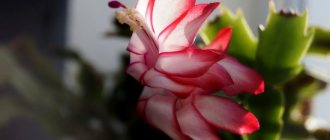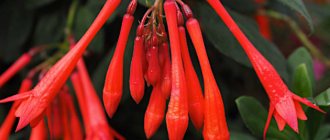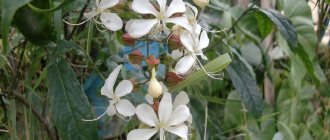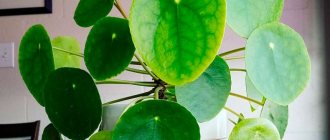Cineraria (ragus, senecio) (Cineraria) is a herbaceous, beautifully flowering plant of the Asteraceae family, which in nature is a perennial, but in indoor and garden floriculture it is most often grown as an annual crop.
The homeland of cineraria is the Canary Islands, the flower is also quite common in the Mediterranean and tropical regions of Africa. The shoots of the plant are erect or drooping, covered with soft dark green leaves, the surface of which is slightly pubescent. Cineraria blooms with small but numerous chamomile-shaped flowers, collected in lush inflorescences-baskets. Flower petals can be colored in a variety of shades of blue, pink, crimson and other colors, depending on the plant variety.
Also see how to grow indoor gerbera.
| High growth rate, up to 30 cm per year. |
| Blooms from January to April. |
| Average difficulty of growing. |
| Grow for 1 year and discard after flowering. |
Useful properties of cineraria
In addition to its attractive appearance, cineraria also has the ability to purify and ionize the air in the room where it is located. By absorbing toxic compounds and enriching the environment with oxygen and phytoorganic substances, the plant noticeably improves the microclimate of the home, which ultimately has a beneficial effect on the well-being of its owners.
Cineraria in landscape design, combination with other plants
Both flowering and decorative foliage varieties are used in landscape design. Silver balls will be an excellent decoration for a border, filling a border, or the foreground of any type of flower bed. They are planted with salvia, decorative maple, and aster. Silver perfectly sets off the emerald crowns of other garden inhabitants. Against such a background, any flower seems brighter and more saturated.
Low-growing flowering ragworts are used for finishing borders, decorating hanging flowerpots, and balcony planting. Bright balls form multi-colored spots on the lawn and mixborder.
Lobelia, sage, marigolds, alyssum, and petunia will be good neighbors. Tall hybrids will become a chic background of an alpine hill or decorate the central part of a spacious flower bed. They look great in a mix of different shades or in company with other astrological flowers.
Know! Florists also noted the high decorative value and long-term freshness of cut flowers.
Having learned about the many faces of cineraria, you will probably want to grow them in your garden; the planting and care described in the article along with colorful photos of strange tropical plants will help with this.
Cineraria: care at home. Briefly
| Temperature | In summer – room temperature or slightly higher (but not more than +25°С), in winter – low (about +15°С). |
| Air humidity | Moderate. The plant can be sprayed periodically, protecting flowers and buds from moisture. |
| Lighting | Intense but diffuse. |
| Watering | Regular, moderate, without overflowing or drying out the soil. |
| Soil for cineraria | Loose, nutritious, slightly acidified or neutral. |
| Feeding and fertilizer | Single season plants are not required. Bushes older than a year are fed during the period of active growth 1-2 times a month. |
| Cineraria transplant | Annual when grown for more than one season. |
| Reproduction | From seeds or stem cuttings. |
| Features of cultivation | Cineraria at home does not tolerate stagnation of air and moisture, so it needs regular ventilation and strict adherence to the watering regime. |
Cineraria after flowering
After the end of the season, the summer plants are removed from the flowerbed. To prolong the joy of contemplating your pets, replant several specimens and bring them into a cool room. It is possible to use these bushes as queen cells for obtaining cuttings in early spring. Cut the branches 10 cm long, remove the lower leaf plates and root them in a mixture of peat, garden soil, and sand.
Remember! Indoor ragwort (hybrid) reproduces exclusively by seeds.
Caring for cineraria at home. Details
Cineraria bloom
A cineraria plant at home, with proper care, can bloom at any time of the year, but usually the flowering period occurs in the spring months.
Corymbose inflorescences are located at the tops of adult shoots and consist of many small red, lilac, violet, white or pink flowers, similar to daisy flowers.
Temperature
During the active growing season, cineraria prefers moderate heat and develops well at a temperature of +22-25°C. In winter, the plant needs coolness and an air temperature of no more than +15°C - only in such conditions is it able to form flower buds for the next season.
Spraying
Caring for cineraria at home may include regularly spraying the plant with warm, settled water, although the flower develops normally even at normal room humidity.
When spraying, it is important to ensure that water does not get on the flowers and buds.
Lighting
Cineraria is photophilous, but does not tolerate direct sunlight, so it is best to place it on an eastern or western windowsill. A south-facing window will also work, but the plant will need to be shaded from the midday sun.
Watering cineraria
Water the cineraria very sparingly throughout the growing season, avoiding either overwatering or drying out the earthen coma.
For watering, you should use only warm, settled water, otherwise the plant will get sick.
Pot for cineraria
At home, cineraria grows a fairly voluminous root system, so the growing container needs to be selected to be spacious so that the plant has the opportunity to develop normally. At the same time, the pot should not be too large - in this case the cineraria will “refuse” to bloom.
Priming
Any loose nutrient substrate with a neutral or slightly acidic reaction is suitable for growing cineraria. You can purchase a soil mixture for beautiful flowering plants at a flower shop or prepare the soil yourself by mixing leaf soil with peat and compost in a ratio of 2:1:0.5.
Feeding and fertilizer
In properly selected soil, homemade cineraria, which grows as an annual, does not need fertilizing.
Plants older than one year are fed during the period of active growth 1-2 times a month with liquid flower fertilizer.
Cineraria transplant
Plants from one season are thrown away after flowering, so there is no point in replanting them.
Cineraria bushes can be saved for the next year; to do this, after all the flowers have withered, the stems are shortened a little, and the plant itself is carefully transplanted into a new pot with a diameter slightly larger than the previous one.
Transplantation of cineraria is carried out using the transshipment method.
Trimming
Cineraria forms a compact and dense crown on its own, so it does not need additional pruning. However, in order for the plant to retain its decorative and attractive appearance for as long as possible, it is recommended to regularly remove wilted flowers and yellowing leaves.
Rest period
Most often, faded cineraria is simply thrown away, but if the plant is planned to be grown as a perennial, it is given a short rest period after the flowers have withered. At this time, the plant is cut by about half and transferred to a cooler, but well-lit room.
Watering is reduced to the required minimum, fertilizing is temporarily stopped.
Growing cineraria from seeds
As practice shows, it is best to grow these plants through seedlings. It is almost impossible to create the necessary conditions in the garden. Only Cineraria graceata can be sown directly into open ground - its unpretentiousness to growth conditions allows the use of such agricultural technology. The young shoots are very tender and need to be protected as much as possible from weather disturbances, so the easiest way to grow these flowers is using the seedling method.
Since cineraria seeds are very small, they do not require embedding in the ground when sowing. It is enough to lay them on the surface of moistened soil, lightly compact them and cover the vessel with the sown seeds with film or glass. Having a fairly high germination rate, they will sprout in about 10-14 days.
Picking is done when the sprouts form 2 true leaves. The delicate root system does not tolerate damage quite well, so you need to replant the seedlings with a lump of earth, which will preserve the roots and ensure rapid rooting in a new place.
Cineraria transplantation
Sowing cineraria for seedlings and transferring it to a permanent habitat is carried out at different times, depending on its variety:
- Primorskaya - sowing in March, planting at the end of May;
- indoor - sowing in December, planting after 8-9 months;
- graceful - sowing in early April, planting in mid-May.
Cineraria indoors grows in a very dense bush
There are two ways in which cineraria reproduces - from seeds and vegetatively. The cuttings are rooted in a greenhouse or under individual shelters, for which you can use plastic bottles cut to the required height.
A stunning hybrid variety of indoor cineraria with curled petals
Diseases and pests
Cineraria is easily infected by various viral and fungal diseases and reacts painfully to mistakes made during the growing process:
- Cineraria stems stretch when there is insufficient lighting. The plant should be moved to a lighter windowsill, not forgetting about shading from the hot midday sun.
- Fluffy gray spots on the leaves are a sign of damage to the plant by gray rot, which most often appears due to high humidity combined with low air temperature. The infected parts of the flower are immediately removed, the cineraria itself is transplanted into fresh soil and treated with a special anti-rot preparation, which contains copper.
- Cineraria does not bloom if it is too hot or does not have enough light. Another reason is systematic violations of the watering regime. Having corrected all the mistakes in caring for the plant, you can hope for buds and flowers to appear on it soon.
- Cineraria leaves turn yellow when watering is poor or the cineraria is kept in a cold room. Fading leaf blades must be removed, and soil temperature and humidity adjusted to optimal levels.
Cineraria is quite often attacked by various pests; the plant is especially loved by spider mites, whiteflies, and aphids. Modern insecticidal preparations for indoor plants are a great help in the fight against dangerous insects.
Unusual cineraria - sea foam, silvery, gray in the garden and in the park
Did you like the article? Share with your friends and like!
Facebook Twitter VKontakte
NEWS DELIVERY BY MAIL IS CONVENIENT
When you subscribe, you will receive an email about new articles posted on the site over the past two weeks.
Types of Cineraria domestica with photos and names
Bloody Cineraria (Cineraria cruentus)
The most common hybrid species in indoor floriculture, combining many varieties with straight, highly branched stems and lush green lacy foliage. Varieties of bloody cineraria differ in the color of their inflorescences: the flower petals can have red, purple, blue, white and many other shades.
Popular varieties of Cineraria Bloody
Grandiflora
A medium-sized variety with lush inflorescences-baskets of many medium-sized flowers with bright crimson or lilac petals and dark cores surrounded by a white border.
Stellata
A tall variety (up to 90 cm) with simple star-shaped flowers, which have dark cores and narrow petals of a deep blue or purple hue.
Multiflora Nana
A compact plant with numerous flowers, which have bright crimson, white or pink petals and centers of a contrasting shade.
Double
A medium-sized shrub that blooms with simple chamomile-like flowers collected in lush inflorescences of a basket. The color of the flowers is two-color, contrasting.
Cineraria Graceful
The bushes of the plant are densely branched and spherical in shape. The bright green dissected leaves are slightly pubescent with thin sticky fibers. Simple or double flowers with red-scarlet, purple-pink or white petals are collected in lush corymbose inflorescences.
Currently reading:
- Oxalis - care and reproduction at home, photos of species
- Jacobinia - growing and care at home, photos of species
- Aeonium - care and reproduction at home, photos of species
- Scindapsus - home care, photos of species, reproduction
- Vanda Orchid - growing and care at home, photo
general information
Cineraria is a herbaceous plant or subshrub, so it is good in landscape compositions. The unusual and sonorous name of the flower is literally translated as “ashy”. This is a tropical guest who came to us straight from the African tropics and Madagascar.
The height of different varieties of cineraria differs several times: from 30 to 90-95 cm. They have branched stems with large leaf plates covered with small edges. Cineraria leaves are oval, lyre-shaped or dissected.
Cineraria has large corymbose inflorescences of all colors of the rainbow from yellow to purple. Large baskets of smooth or terry petals surround a voluminous velvety center. The beauty of flowering will delight you from the beginning of summer until the cold weather. Some species are used when making bouquets and are grown specifically for cutting.
Photo: 2sotki.ru
Use in folk medicine
According to folk medicine, this plant has specific decongestant properties for the eyes: it is used in the preparation of eye drops and in the treatment of cataracts.
Senecin (a resinous substance) and sencinine (a very toxic alkaloid) were found in the rhizomes of these plants: for this reason, modern medicine does not recommend its uncontrolled use, only under the supervision and on the recommendation of a competent doctor.
Cineraria, particularly the maritim variety, is a medicinal plant widely used for its soothing, decongestant and anti-inflammatory properties.
In homeopathy, it is a natural remedy used for conjunctivitis, eye inflammation, eye strain and hypersensitivity. Its drops are effective for allergic manifestations, even acute ones, replacing eye medications with cortisol.
Propagation by seeds and cuttings
Planting of cineraria by cuttings occurs in July and August: 8-10 cm pieces of branches are taken from the side shoots and planted either directly at home or in a box with a mixture of peat and sand in equal parts; at the time of rooting, the plants can be planted in April.
Cultivation by seeds is carried out at the end of winter for plants with winter flowering or in the period May - July for spring flowering. It is advisable to sow in advance in prepared trays with soil for flowering plants mixed with 40% sand.
It is necessary to maintain constant soil moisture, especially during germination, at a temperature that does not fall below 15 ° C.
About a month after germination, the seedlings can be transplanted either into the garden or into flower boxes, spaced 20-25 cm apart to ensure uniform flowering. The time from germination to flowering of new plants is about 7 months.
Watering the plant
Like most plants grown in pots, cineraria does not tolerate stagnant water. You need to wait until the soil is completely dry before watering and make sure the saucer is dry. Moreover, you can use drainage material at the bottom of the flowerpot to facilitate water removal.
As for the choice of soil, all types and varieties of cerenaria love fertile substrates mixed with peat and sand, which make drainage more efficient. There is no need for pruning, just remove wilted or damaged leaves and flowers from time to time. Flowering occurs from April to May, and propagation is by seeds and cuttings.
Characteristics and description
Cineraria vulgaris has slightly elongated leaves, which are large in size at the bottom of the stem and become smaller and smaller along the length of the stem.
A distinctive feature of this plant is its spectacular and abundant flowering. Cineraria flowers are clustered in particularly vibrant golden yellow, purple, blue, red, pink and purple flower heads. Sometimes the inflorescences are two-colored.
Among the many varieties of cineraria, there are also dwarf and semi-dwarf varieties, especially suitable for growing in pots. In the photo of cineraria, the jagged leaves look impressive during the non-flowering period, and during flowering the inflorescences completely cover the surface of the plant.
Cineraria maritima has the characteristics of a succulent and is widely used to decorate gardens and terraces due to its ash-gray leaves and silvery down that envelops the stems and leaves. The leaf is also white and silver on both sides and is therefore extremely decorative. It is easy to find on the Black Sea coast.
There are several cineraria hybrids, specially bred to improve their picturesque and decorative characteristics. Of the hybrids, Cineraria cruenta is the most common variety, blooming in shades of blue, pink and blue. It is suitable for pot growing indoors.
Numerous hybridizations have been obtained from this species, including Senecio cruentus, Grandiflora, Multiflora nana and Stellata, so called because of the characteristic star-shaped flower heads.











